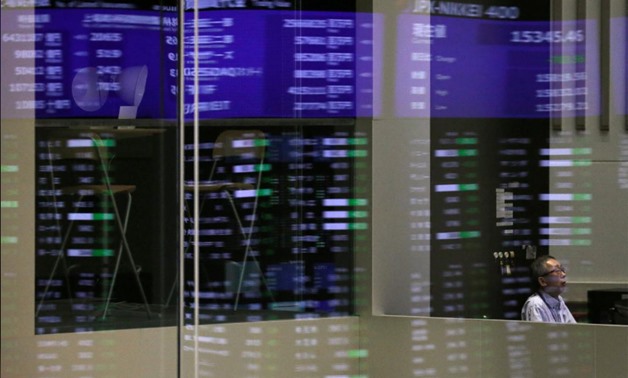
Market prices are reflected in a glass window at the Tokyo Stock Exchange (TSE) in Tokyo, Japan, February 6, 2018. REUTERS/Toru Hanai
SYDNEY - 27 March 2018: Asian share markets sprang higher on Tuesday as reports of behind-the-scenes talks between the United States and China rekindled hopes that a damaging trade war could be averted, in turn sapping life from the dollar and yen.
Taking a cue from Wall Street, Japan's Nikkei .N225 enjoyed its best day in almost three months, jumping 2.3 percent.
MSCI’s broadest index of Asia-Pacific shares outside Japan .MIAPJ0000PUS rose almost 1 percent, while China blue chips .CSI3000 added 0.9 percent.
Futures for the FTSE FFIc1 rose 1.2 percent and spread betters pointed to steep gains for other European bourses, while E-Mini futures for the S&P 500 ESc1 firmed 0.3 percent.
The abrupt mood swing came amid reports Chinese and U.S. officials were busy negotiating to avert an all-out trade war.
White House officials are asking China to cut tariffs on imported cars, allow foreign majority ownership of financial services firms and buy more U.S.-made semiconductors, said a person familiar with the discussions.
Chinese Premier Li Keqiang on Monday pledged to maintain trade negotiations and ease access to American businesses.
“The recent escalation may have simply been a negotiating tactic that will end in a compromise,” wrote analysts at JPMorgan. “This would be consistent with the pattern around the steel/aluminum tariffs and is the interpretation that many market commentators are favoring.”
Yet they warned it was too early to say for sure, given President Donald Trump has had deeply held views on fair trade for decades.
YEN RETREATS
Even a whiff of a deal was enough to propel Wall Street to its best day in 2-1/2 years and deliver the Dow its third-biggest point gain ever.
The Dow .DJI jumped 2.84 percent, while the S&P 500 .SPX climbed 2.72 percent and the Nasdaq .IXIC 3.26 percent.[.N]
The sudden bout of optimism helped offset news that the United States and many of its Allies were expelling more than 100 Russian diplomats in retaliation for a nerve agent attack on a former Russian spy in Britain.
The surge in stocks dragged on the Treasury market, which faces a record $294 billion of new supply this week. Yields on 10-year Treasury notes US10YT=RR inched up to 2.856 percent, but remained short of last week’s top at 2.90 percent.
In currency markets the reaction was to offload both the yen and the U.S. dollar as appetite for riskier assets revived.
“The yen is being quietly sold as risk hedges are unwound and looks particularly vulnerable on the crosses,” Citi analysts said in a note.
Short-covering against the euro was especially sharp as the common currency jumped 1.4 percent overnight EURJPY= to stand at 131.51 yen.
That allowed the U.S. dollar to bounce to 105.61 yen JPY=, having been at its lowest since late 2016 at one point. Yet the U.S. currency ran into selling against almost everything else, with notable breaks by the euro and sterling.
The euro was up at $1.2450 EUR=, after cracking the March top at $1.2446, and bulls were eyeing the peak for the year so far at $1.2556.
The broad-based softness kept the dollar retrained against a basket of currencies at 89.063 .DXY, after touching a five-week trough of 88.979.
The improved mood on trade gave a fillip to industrial commodities, with copper and iron ore bouncing, while spot gold XAU= inched up to $1,353.61 an ounce.
In oil markets, U.S. crude futures CLc1 put on 29 cents to $65.84 a barrel, while Brent crude LCOc1 added 18 cents to $70.30 a barrel.

Comments
Leave a Comment